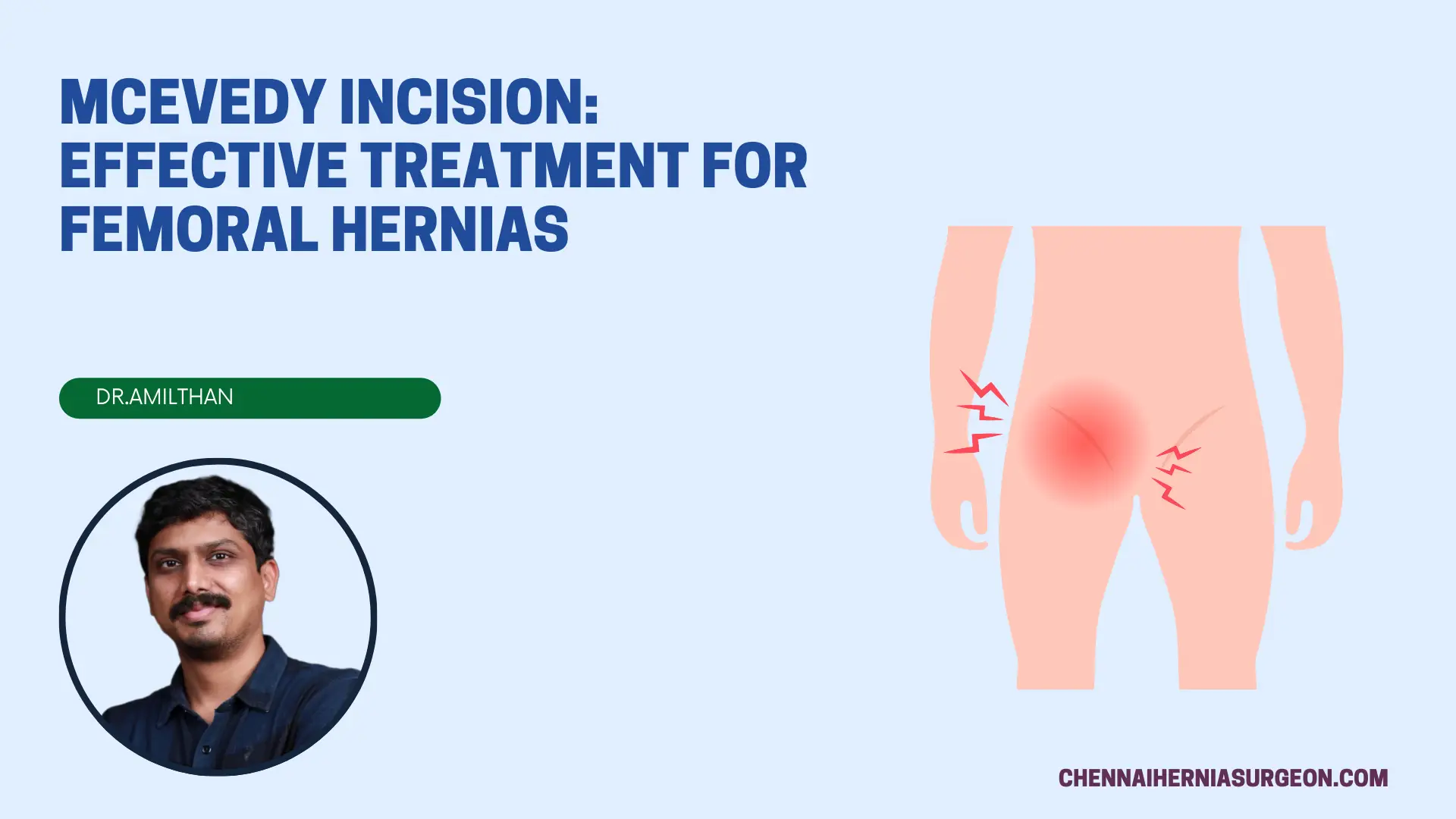McEvedy incision is a type of incision method used to treat femoral hernias. There are three incisional methods that can be used to treat femoral hernias:
- Lockwood’s infra-inguinal incisional approach,
- McEvedy’s high incisional approach, and
- Lotheissen’s transinguinal approach.
Each incisional approach is different and provides different ways to access the femoral sac. In this article, we’ll look deeply into McEvedy’s incisional method and how incisional hernias can be diagnosed and treated.
What is McEvedy Incision?
McEvedy incision is the lateral paramedian vertical incision made in the lower abdomen along the lateral margin of the rectus muscle. It is one of the three incisional methods that can be used to perform femoral hernias.
What is the McEvedy Incision Used For?
The McEvedy incision is a high operation performed to treat femoral hernia. This incision opens up the femoral space and allows doctors to access the femoral canal and peritoneum.
McEverdy incision is an effective approach to treating femoral hernia. However, they offer only minimal access to the peritoneum. Moreover, this incision is done on top of the femoral canal, so the procedure should be done with care so as not to injure the femoral artery, vein, or nerve.
What are the Causes of Incisional Hernias?
An incisional hernia occurs when a tissue or organ pushes through and protrudes from the site of a previous operation in the abdominal wall. It mainly happens when the muscles around the incision site weaken, and organs push through them. This is common in most abdominal surgeries.
Some factors that can cause incisional hernia are
- Old age,
- Previous abdominal surgery,
- Chronic cough after surgery,
- Postoperative complications like hematoma/seroma formation,
- Infection in the surgical site,
- Morbid obesity,
- Patient-related factors like systematic diseases such as DM, smoking, malnutrition,
- renal failure, etc.
- Technical factors such as surgical techniques and suture material used
- Disease-related factors like incision site, timing, and urgency (elective/emergency) of procedure
What are the Different Types of Incisional Hernia Surgery?
There are several types of incisional hernia surgeries. Some of them are listed below.
- Herniotomy (removal of the hernia sac only)
- Herniorrhaphy (herniotomy along with repairing the posterior wall)
- Hernioplasty (herniotomy along with reinforcing the posterior wall with a synthetic mesh)
- Laparoscopic mesh repair
How are Incisional Hernias Diagnosed?
Incisional hernias can be diagnosed through the following methods.
- It can be diagnosed clinically by taking a detailed history of previous abdominal surgeries
- It can be diagnosed by doing a clinical examination for reducible swelling and tenderness at the site of the previous operation. This can further be confirmed through a radiological examination.
- It can also be diagnosed by seeing or feeling a bulge in the surgical site when the patient coughs.
Conclusion
McEvedy’s incision is an effective approach to treating femoral hernias. If you suspect you have a hernia, ensure you visit an expert laparoscopic surgeon and get your condition diagnosed.
It is best to treat a hernia when it is in its early stages. Leaving it for too long can lead to loss of blood supply and cause necrosis (strangulation and death of tissue). This can be fatal to your life.
FAQs
An incisional hernia occurs when the muscles of a previous surgery that are held together by sutures weaken over time, and the organs or tissues around them start pushing through them.
Generally, excess pressure on an organ or your intestines is the main cause of hernia. A hernia arises when this pressure occurs in the same region where you have a weak muscle or tissue.
Some people are born with weak muscles or underdeveloped tissue. Most people, however, get hernias when their bodies age and their muscles weaken.
- Some factors that can cause incisional hernia are
- Old age,
- Previous abdominal surgery,
- Chronic cough after surgery,
- Postoperative complications like hematoma/seroma formation,
- Infection in the surgical site,
- Morbid obesity,
- Patient-related factors like systematic diseases such as DM, smoking, malnutrition, renal failure, etc.
- Technical factors such as surgical techniques and suture material used
- Disease-related factors like incision site, timing, and urgency (elective/emergency) of procedure
Most patients feel well enough to resume daily activities, such as driving and returning to work within a few days. However, limiting activities to two weeks is best to allow for sufficient recovery. Patients should not exercise or undertake any heavy lifting for the first two weeks following hernia surgery.





